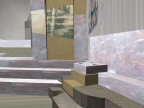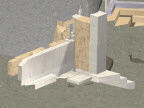
|
|
 |
|
In the November, 1996, Newsletter there was an article by George Tressel describing the creation of renderings of the older propylon ("Visualizing the Ancient World"). Mr. Tressel has been working with the program 3D Studio® in order to make good renderings of the older propylon.
In March he succeeded in applying color photographs to parts of the model so that the actual photos of the blocks appeared on the model. Previously, he had been able to apply only generic textures supplied by computer companies. Figures 1 and 2 illustrate the result, with only a part of the blocks shown with the photographic overlay.
 |
 |
| Fig.1- Lower Courtyard | Fig. 2 - Upper Courtyard. |
As you can see, the result looks truly photographic in the area where the photos were used. However, it is not necessarily the desired effect, because the stones look just as they do in life today - stained by time and weather. The preferred effect is to show the structure as it was in antiquity; so Mr. Tressel took some images of the marble where it is unstained and created a texture map that could be used on the marble blocks. He did the same with the poros blocks of the parastas. The result is shown in Figures 3 and 4.
 |
 |
| Fig. 3- Lower Courtyard | Fig. 4 - Upper Courtyard. |
The images are much more representative of what the older propylon would have looked like in antiquity than the typical, heavily-grained marble appearance achieved with only generic textures. This is an on-going experimental process; new results will be illustrated regularly.
For other Newsletter articles issues concerning the use of CAD in archaeology and arcitectural history, consult the subject index.
Next Article: Web Server Missing in Action
Table of Contents for the Spring, 1997 issue of the CSA Newsletter (Vol. X, no. 1)
 Table of Contents for all CSA Newsletter issues on the Web
Table of Contents for all CSA Newsletter issues on the Web